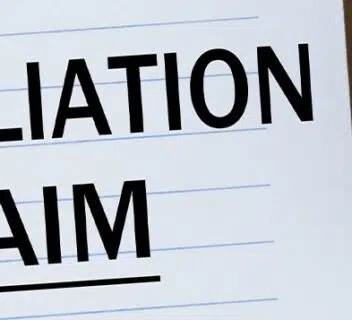How do you prove retaliation in the workplace? Gathering the right evidence and understanding what constitutes retaliation are key steps in learning how to prove retaliation in the workplace. This article will explain the necessary steps to identify retaliation, collect supporting evidence, and build a strong case to protect your rights.
Key Takeaways
- Workplace retaliation is unlawful and occurs when an employer takes adverse actions against an employee for engaging in protected activities such as filing complaints or reporting unsafe conditions.
- A strong retaliation case requires proving participation in protected activities, experiencing adverse employment actions, and establishing a causal connection between the two, often necessitating legal assistance.
- Collecting and documenting evidence, including witness statements and detailed incident records, is essential for substantiating a retaliation claim and facilitating the complaint process with HR.
Understanding Workplace Retaliation
Retaliation in the workplace refers to when an employee faces negative treatment from their employer as a result of engaging in protected activities or asserting their rights, which can lead to a hostile work environment. Federal and state laws deem such retaliation unlawful under both state and federal law, forbidding adverse actions by employers against employees who have lodged complaints regarding illicit conduct, discrimination, serious malpractices, or threats to public safety or health—including instances of retaliation itself.
Employees are protected by anti-retaliation provisions that ensure they can engage in these protected activities without fear of retribution. Consequently, it’s illegal for employers to retaliate against staff members who report problems or participate in inquiries into alleged discrimination or opposing workplace discrimination—regardless if those employees are directly implicated.
Understanding what is considered retaliation under the law is vital since its repercussions extend beyond professional life affecting one’s psychological and emotional health. These insights serve as essential tools for individuals looking to protect their legal rights while fostering an equitable atmosphere at work.
Key Elements of a Strong Retaliation Case

To construct a solid retaliation claim, it is essential to demonstrate three primary components: involvement in protected activities, suffering from negative employment consequences, and showing a direct link between these occurrences. If any of these elements are not substantiated, your case may be rejected.
Every part is vital for illustrating that the adverse actions taken by an employer were a direct consequence of engaging in a protected activity and that these actions would deter a reasonable employee from exercising their legal rights. Often legal aid becomes crucial in successfully establishing this connection and proving retaliatory intent, reinforcing the foundation of your retaliation case.
Participation in Protected Activities
Engaging in protected activities involves employees standing up for their rights as recognized under different labor laws. Such actions encompass submitting grievances, being part of inquiries, alerting authorities about hazardous work environments, exposing illegal activities within the organization, and lodging objections regarding workplace discrimination or harassment, including unlawful discrimination.
The Equal Employment Opportunity Commission (EEOC) distinguishes between participating in legal procedures and actively resisting employment discrimination or harassment when categorizing types of protected activities. Recognizing these forms of participation is crucial to establishing a robust retaliation claim connected to employment discrimination.
Adverse Employment Actions
Negative employment actions taken by an employer, which affect an employee’s position or work conditions negatively, can include:
- job termination
- being demoted
- reduction in salary
- fewer hours of work
- less favorable changes to work assignments
When these adverse actions are carried out as a consequence of an employee taking part in activities that are legally protected, they constitute unlawful retaliation.
At times, even the threat of negative consequences such as legal action or deportation may serve as indicators of retaliatory behavior. The crucial point is whether these threats would discourage a typical employee from participating in protected activities.
Identifying such detrimental employment actions is vital for detecting and substantiating claims of workplace retaliation. These adversities can have profound implications on both the professional path and the personal welfare of employees. Hence it’s critical that they be addressed with urgency and efficacy.
Establishing a Causal Connection
Demonstrating retaliation necessitates showing a direct causal link between the activity that is protected and any unfavorable measures taken. Establishing this connection is often difficult, typically relying on indirect evidence. The presence of a short time gap between the engaged-in protected activity and the adverse action can be a powerful sign of causality.
The most compelling evidence comes from remarks that reveal negative reactions to an individual’s participation in protected activities. Describing someone as a troublemaker or lacking team spirit following their engagement in such activities may indicate retaliatory intent and point towards an intention to retaliate.
Should you find yourself questioning whether your proof of causality is substantial enough, seeking advice from an employment lawyer could prove instrumental in assessing the merits of your situation.
Gathering Evidence to Support Your Claim
Gathering proof is essential when establishing a retaliation claim or workplace retaliation claim. Evidence such as emails, voicemails, and testimony from witnesses can support your allegations. It’s imperative to meticulously document every instance of presumed retaliatory actions before bringing the issue to HR.
Should you opt for filing an official complaint or initiating legal proceedings, documentation will be instrumental in strengthening your case. Maintaining detailed records of all pertinent interactions and paperwork related to your situation bolsters the credibility of your claim by highlighting recurring patterns of retaliatory conduct.
Documentation Tips
It is essential to record precise information when noting instances of retaliation, such as the dates, times, places, and narrative accounts of what occurred. Demonstrating a brief interval between engaging in protected activity and experiencing an adverse action could bolster the evidence for a case of retaliation.
For constructing a solid legal argument, meticulous documentation is crucial. Maintaining detailed logs of every incident will support your allegations and offer undeniable proof that there was an intention to retaliate.
Witness Corroboration
Witnesses are vital in substantiating claims of retaliation. To gather this support, it is important to discreetly engage colleagues and provide them with a clear understanding of the circumstances. Their testimony can offer critical reinforcement for your account and enhance the robustness of your legal argument.
The confirmation provided by witnesses can serve as compelling evidence when trying to establish proof of retaliation. Colleagues who are able to bear witness to acts of reprisal significantly contribute toward demonstrating that such retaliation occurred, thereby bolstering a persuasive legal case.
Signs of Retaliation at Work

Recognizing indicators of workplace retaliation is crucial for timely intervention. Typical signs include abrupt adverse evaluations, alterations in job responsibilities, and being left out of meetings, which usually suggest an employer’s reprisal following an employee’s assertion of their legal rights.
The revocation of benefits like access to vital assets might also point to workplace retaliation. Piling on tougher assignments or escalating work expectations, especially after complaints of sexual harassment, could be evidence that an employer is retaliating against a worker.
Keeping an exhaustive record of events can assist in illustrating consistent retaliatory behavior. Chronicling continuous unfavorable measures following participation in protected activities assist in proving the existence of a pattern indicative of retaliation.
Reporting Retaliation to HR
Should you have concerns about experiencing retaliation at your workplace, begin by consulting your employee handbook and adhere to the complaint procedures outlined by your employer. Initiating a formal grievance with Human Resources and actively following up can assist in advancing the process.
It’s crucial for employees who lodge complaints to be knowledgeable about the expected duration and sequence of HR investigations. Being well-informed regarding how to proceed with filing a complaint empowers you to efficiently manage it and stand up for your entitlements.
Legal Help for Retaliation Claims

If you have suffered from workplace retaliation, it is essential to enlist the expertise of a workplace retaliation lawyer or workplace retaliation attorney. These legal experts are adept at collecting evidence, navigating negotiations, and fervently representing your interests in court. They will also guide you through your legal choices and enhance the solidity of your case by addressing all intricate legal details.
In terms of compensation for retaliation claims in the workplace, possible rewards may cover lost wages due to unlawful employment actions as well as damages for emotional distress or even punitive measures against those responsible. With their assistance, complaints relating to retaliatory behavior can be effectively lodged with relevant government entities.
Choosing a Qualified Lawyer
Choosing an experienced attorney is imperative when tackling workplace retaliation claims. It’s important to evaluate a lawyer’s track record in dealing with such cases. We encourage you to opt for attorneys who provide free consultations, as this can be instrumental in determining whether they fit your particular situation.
A skilled employment attorney provides essential advice and assistance during the course of navigating through employment law proceedings. Ensuring that you have a competent lawyer on your side means your case will receive the attention and skill it warrants.
Contact 1-800-THE-LAW2 today for a free legal consultation with an attorney in our professional network.
What to Expect During Legal Proceedings
Grasping the intricacies of the legal procedure in retaliation claims is essential for successfully maneuvering through a case. Maintaining a clear and effective dialogue with your attorney guarantees that they can advocate on your behalf adequately.
Choosing an adept lawyer requires a thorough assessment of their expertise, particularly in regard to dealing with retaliation claims. It’s vital to opt for an attorney who boasts considerable accomplishments in triumphantly steering such cases.
Summary
To establish a convincing case of workplace retaliation, it is imperative to grasp the essential components that constitute such a claim, collect relevant evidence, and be vigilant in identifying indicators of retaliatory behavior. It’s crucial to report any concerns to Human Resources and pursue legal guidance in order to safeguard your rights effectively.
It’s vital to advocate for yourself as asserting your rights plays an integral role in fostering an equitable and righteous work atmosphere. By heeding this advice and enlisting appropriate assistance, you can adeptly deal with the intricacies associated with retaliation at work and make certain that fair treatment prevails.
Frequently Asked Questions
What constitutes a protected activity?
Engaging in protected activities, which include filing grievances, participating in inquiries, alerting authorities to hazardous situations, and exposing illegal actions through whistleblowing, is crucial for defending individual rights and enhancing safety within the workplace.
What are some examples of adverse employment actions?
Adverse employment actions include termination, demotion, salary reductions, reduced work hours, and unfavorable changes in work assignments.
These actions can significantly impact an employee’s career and workplace environment.
How can I prove a causal connection between protected activity and adverse action?
To prove a causal connection between protected activity and adverse action, establish close temporal proximity, provide direct evidence, and document any new difficulties encountered at work.
These steps can effectively demonstrate the necessary link.
What should I do if I suspect workplace retaliation?
If you suspect workplace retaliation, review your employee handbook and document all incidents carefully.
It is also advisable to follow company reporting procedures and seek legal advice if necessary.
What can I expect during legal proceedings for a retaliation claim?
During legal proceedings for a retaliation claim, you can expect to gather evidence and work closely with your lawyer to navigate the complexities of the process.
Professional guidance will be essential as you move forward.





